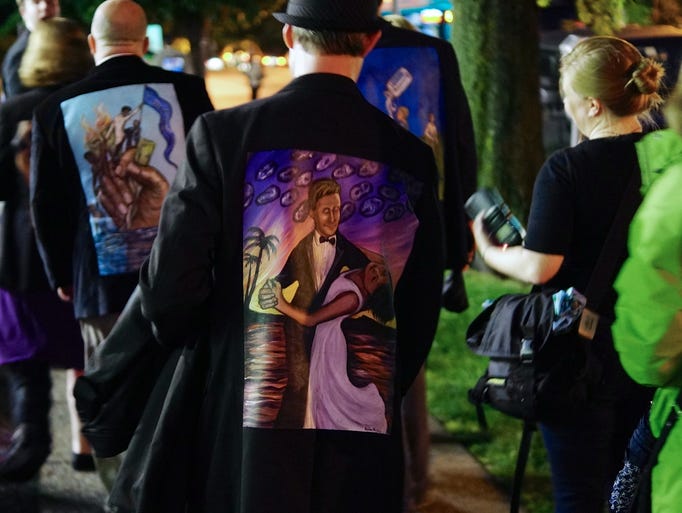Despite her grief and background, Holliday has emerged as a colorful patient advocate with a command of electronic health record rules to rival any button-downed lobbyist.
The color comes in the form of more than 330 pictures she's painted on jackets to tell the stories of patients, doctors and others involved in health care. Those who get the free paintings agree to wear them to at least two medical conferences a year, which creates a "Walking Gallery of Healthcare " that 43 other artists have joined.
Holliday's art-based advocacy started as a Washington, D.C., mural about medical data access in 2009, in which she tried to make the case that patients and their families need early and full access to electronic health records. That's something Holliday couldn't get as husband Fred was moved rapidly between hospitals, rehab centers and hospice.
As doctors and hospitals fight to get rules relaxed to give them more time and fewer requirements, Holliday is on the other side pushing for the process to be sped up.
Some of those who wear Holliday's jackets are patients with chronic or fatal diseases. Others range from doctors to policy makers to powerful industry players. They include Karen DeSalvo , who heads the federal Office of the National Coordinator for Health Information Technology , Todd Park , the former U.S. Chief Technology Officer and Jonathan Bush , CEO of health IT company Athenahealth .
"It's a major labor of love," Holliday says of her painting.
And it's a way to give voices to people who can be overlooked in policy debates, especially on an arcane subject like digital medical records.
When Holliday first started going to medical conferences after her husband's death, she noticed there were no people who identified themselves as patients. So she convinced many of those willing to tell their private health stories to let her do so in art. The paintings show these patients' struggles with conditions including Lupus, cancer and mental health, an area where patients and their families have particular challenges getting records due to privacy concerns.
She could relate to all of them as "I'm a really regular person," says Holliday. Now, however, she's also a paid keynote speaker at health conferences and a policy wonk.
Fred was also a regular guy — and a father of two young sons — who spent years working in a video store while going to school. The year before his death, however, Fred got his doctorate in film studies and became a professor of film at American University . He was so proud, Holliday says.
He had been going to the doctor off and on for about six months for problems that turned out to be symptoms of his cancer. Still, he kept being prescribed pain medication. After doing her own research into what appeared to be something wrong with his spine, Holliday concluded something must be wrong with his kidneys and demanded an MRI.
At the first hospital, Holliday was told it would take 21 days for her to get a copy of Fred's medical records and 73 cents per page for the 162 pages. By that time, Fred was already in the next hospital and close to being sent to hospice.
Access to the records early would have helped the couple make better-informed decisions and allowed "us to see how extreme the spread of his disease was," says Holliday.
Now, she wants everyone else to have that access. Up against a powerful and well-financed industry, Holliday isn't about to give up. One of Fred's doctors called her "Little Miss A-Type Personality," for her pushiness in getting his records. So she put that on one of her jackets.
She's also a survivor. Her late father, an alcoholic, physically and sexually abused her when she was young and she made that part of her new memoir, The Writing on the Wall. "I wanted regular folks to know what it's like to be hospitalized without information," says Holliday. "If I explained what happened to me as a child back when we didn't talk about those things, I was hoping that people might see what feels like abuse in hospitals and would change things more rapidly."


No comments:
Post a Comment